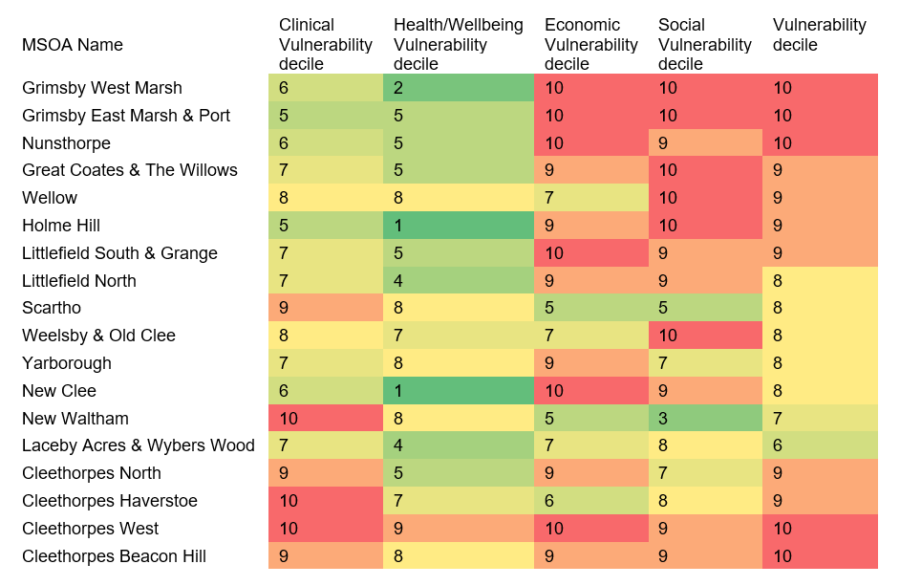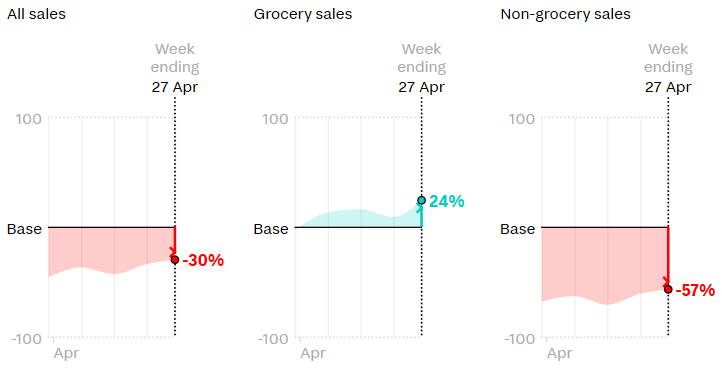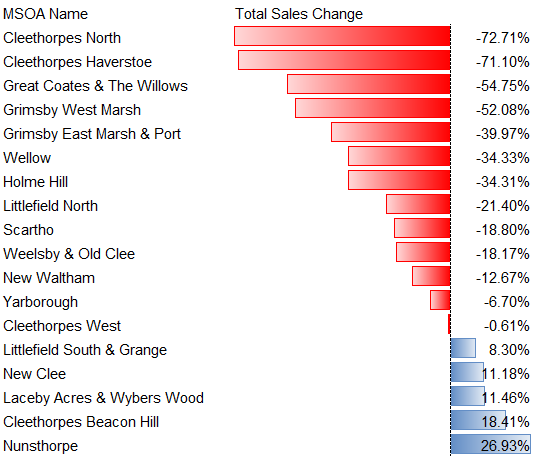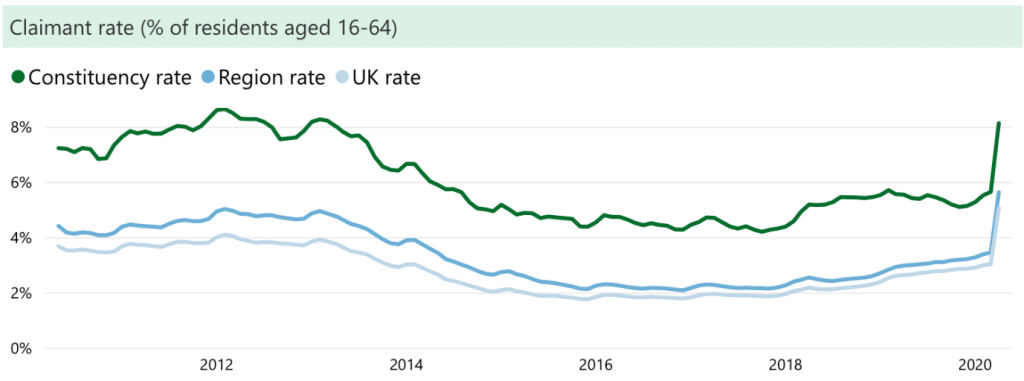COVID-19: Grimsby Deep Dive

Key Achievements
Alongside our work with Tortoise, we’re working on a COVID-19 & Communities data sprint to drill a little deeper into what the current crisis means for the social economy. Our Policy Lead Will Thomson explores this within the context of places and people.
This week’s Tortoise Deep Dive takes us from the coast of the South West to the North East. We want to dig a little deeper into how the coronavirus pandemic is affecting places and peopleacross the country.
The crisis appears to be having two kinds of impact:
A health crisis and emergency for densely populated areas with a high prevalence of pre-existing health risks.
A broad and deep economic shock to local economies across the country, regardless of exposure to the virus.
Our collective response therefore needs to consider how places have been impacted differently by the pandemic and deploy resources in ways that fairly respond to varying needs. To get a better understanding of what this looks like in one area, we’ve taken a deep dive into Grimsby to look at the effects of COVID-19 and the lockdown on the town. Though North East Lincolnshire currently has a very low COVID-19 exposure, it is experiencing the same collapse in economic activity that we’ve seen elsewhere in the country. We want to explore what this means for the local economy in Grimsby and how this should inform our response to the crisis there.
Grimsby’s main economic sectors are in ports and logistics, food processing, chemicals and process industries and digital media. Towards the east, the smaller seaside resort of Cleethorpes is more reliant on tourism and hospitality. According to the British Red Cross Covid-19 Vulnerability index – bringing together datasets that cover both health and wellbeing and socio-economic indicators – areas in both Grimsby and Cleethorpes are among the most vulnerable in the country. Note that the risk in Grimsby lies more with its socio-economic conditions (e.g. employment vulnerability, benefit claimants), whereas areas in Cleethorpes register a higher clinical risk (e.g. pre-existing health conditions and proportion of the population over 70).

Figure 1: Covid-19 Vulnerability Index for Grimsby and Cleethorpes
Source: British Red Cross Vulnerability Index
Looking at transaction data for Grimsby as a Travel to Work Area, we can see a 30% drop in total sales when compared with the week ending 27 April 2019. This puts Grimsby in the middle of towns and cities listed in Tortoise’s Corona Shock Tracker – it is a similar decline to places like Telford, Chesterfield and Sunderland. However, this obscures some significant variance at a local level.

Figure 2: Sales changes in Grimsby (Travel to Work Area)
Zooming into Middle Layer Super Output Areas (MSOA) we can see a significant collapse of up to 70% in the seafront areas of Cleethorpes, while West Mash in Grimsby has seen a decline of just over 50%. This is broadly in line with the trends across the country – where coastal towns and other areas reliant on retail, tourism and hospitality have been hit hardest. Grimsby’s main shopping area is in West Marsh and part of East Marsh, which would explain why these areas have seen steeper drops.

Figure 3: Total sales change for week ending 27 April in Grimsby & Cleethorpes MSOAs
As these are small areas, there are some anomalies: for example, the relative increase in spending in Nunsthorpe, or the large decrease in Great Coates and the Willows. These areas could be influenced by anything from the presence or lack of a large supermarket, to differing spending behaviours, transport availability, or other socio-economic factors in these communities.
The picture, then, is largely negative – with a significant drop in local economic activity in Grimsby and Cleethorpes. But how should we respond to this? We spoke with some local organisations, including two former SIB investees (Foresight North East Lincolnshire and NAViGO Health and Social Care CIC), to get a sense of the on-the-ground effect, and what this could mean for recovery.
Here are the key takeaways:
1. Income and employment should be at the forefront of our response to this crisis.
As the local transaction data shows, the lockdown has seen people stay at home and make significant reductions in their spending. A recent paper from the Centre for Economic Policy Research found that households at the bottom of the consumption and income distributions have experienced the largest percentage decline in both income and expenditure since March. Moreover, the latest data from the Department for Work and Pensions has shown a sharp rise in unemployment benefits claimants in Greater Grimsby, to just over 8% of working age adults – 3% higher than both the region and UK average.

Figure 4: Benefits claimant rate in Greater Grimsby
Source: House of Commons Library
We are at the beginning of what is likely to be a long and deep recession. Unemployment will rise and there will be considerable reductions in local spending power. This will no doubt have had knock-on effects for the local businesses, especially in places that were already economically vulnerable. There will be long-term implications for the ability of the local economy to bounce back once social distancing measures are relaxed.
We are seeing the failures of a labour market with large numbers of people in precarious or insecure work, many of whom have already found themselves unemployed. Our response therefore needs to take a broader view on how to support the creation of good jobs and secure wages for local people through the social economy – where income and employment of the local people are put ahead of profit maximisation.
The social economy has been at the heart of the emergency response and will be equally important during the recovery.
Each of the organisations we spoke to had redeployed resources in some way to support their community through this crisis. Sector Support North East Lincolnshire – the local VCSE sector infrastructure body – spoke of a local community hub, Centre 4, that had restructured their services to support vulnerable groups with shopping, food deliveries and even broadband services. NAViGO – a mental health provider in North East Lincolnshire – had quickly identified vulnerable people in the area and mobilised staff in a ‘shielding process’ to check in with these individuals, deliver prescriptions or provide additional support. The Rock Foundation – a charity that provides services to people with learning disabilities – had redeployed its volunteer base to help at the food bank that it managed.
This demonstrates the value of robust social infrastructure, with organisations being able to quickly redirect resources towards their community and ensure that vulnerable groups get the support they need. With a looming recession and rising unemployment, these kinds of activities will be just as important in the recovery as they have been during the crisis.
2. We need to support organisations to be adaptable, flexible and resilient as they adjust to the long-term effects of the pandemic.
Foresight North East Lincolnshire – a charity with a primary focus on providing a wide range of learning, training, leisure, sporting and social activities for people with disabilities – had suspended all core services during the lockdown. These require close personal contact, with 1:1 support from volunteers and multiple people participating in a class or activity. They do not know when they will be able to resume normal service delivery amidst ongoing uncertainty over the duration of social distancing. In the short term, they are looking at new options for delivering limited services while social distancing – but here a session that used to have twenty people is likely to only be able to accommodate five. This will have a long-term negative impact on the service users and their families, as well as implications for Foresight’s own business model.
Similarly, the Birdhouse Theatre – a social enterprise aimed at increasing local participation with arts and culture – had cancelled its upcoming events programme and was uncertain about when and how it might be able to resume under conditions of social distancing. They were looking into new ways of hosting content online and engaging with families virtually.
On the other hand, NAViGO had managed to shift many of its services online, with certain lower-level services (such as the Improving Access to Psychological Therapies programme) getting higher levels of engagement than ever before. Sector Support told us that several organisations had pivoted to virtual service delivery and were now considering keeping some of these in the future.
Although some organisations will be able to shift to new models of service delivery that accommodate social distancing, this might not work across the board. The organisations whose services or business models relied most heavily on person-to-person contact or communal gatherings – such as disability services, events or office space – are likely to be most affected in the longer term. We need to think about the kinds of assistance that organisations will need, not just financially but also in terms business support to help them adapt to this new environment.
3. The emergency response has taken precedence over longer-term funding and non-essential services – which could lead to new problems down the line.
Foresight found that all funding applications they had submitted before the pandemic had been rejected due to funders redirecting resources to emergency COVID-19 grants. This was despite one funder saying that they would have funded the project under normal circumstances. Similarly, the Rock Foundation had lost all income from the North East Lincolnshire Council after they had suspended their services for people with learning disabilities, putting increasing financial strain on the charity.
There was a more overarching concern that too much grant funding was being targeted towards supporting the emergency COVID-19 response, and this would result in a scarcity of funding and increased competition in the recovery period. Those organisations whose business models are most affected by social distancing in the long-term are likely to face some harsh realities about the viability of some of their services.
These developments are especially concerning when thinking about the recovery. Pre-existing needs have not changed, and many problems will have been indirectly exacerbated by the crisis. Putting longer-term projects and funding streams on hold will likely cause major difficulties in the very near future.
The effects of this pandemic are likely to be protracted and far-reaching, and places that were already economically vulnerable will be hit hardest. In response, we need to think about how to invest in a fair recovery that puts people first, many of whom will have lost their jobs or seen a dramatic reduction in income.
Social businesses, like those we spoke with in Grimsby, will play a vital role in helping communities recover and prosper. Evidence from our loan book shows that the social economy provides more jobs by turnover than the private sector, employs people furthest from the workforce, and delivers accessible services that local communities desperately need. We therefore need to take a wider view on the kinds of finance and support that these organisations will need to help them adapt and thrive in the post-coronavirus world.
As we look to the recovery period, we have an opportunity to rethink how we invest in places and, more importantly, who should benefit from this investment. If we are to see this as an opportunity to build back better, we cannot revert to business as usual. Instead, we need to truly invest in people and the places where they live by building a social economy that enhances welfare, improves living standards, and creates fairer communities.
Thank you to the organisations that took the time to speak with us for this blog:
Foresight North East Lincolnshire
Navigo Health and Social Care CIC
Sector Support North East Lincolnshire
Birdhouse Theatre
Rock Foundation
If you’re looking for a breakdown of the latest Government advice for businesses, and current emergency funding opportunities, visit our COVID-19 Resources and Information
Photo by Bryan Ledgard – https://www.flickr.com/photos/ledgard/434148666/, CC BY 2.0, https://commons.wikimedia.org/w/index.php?curid=58276946
